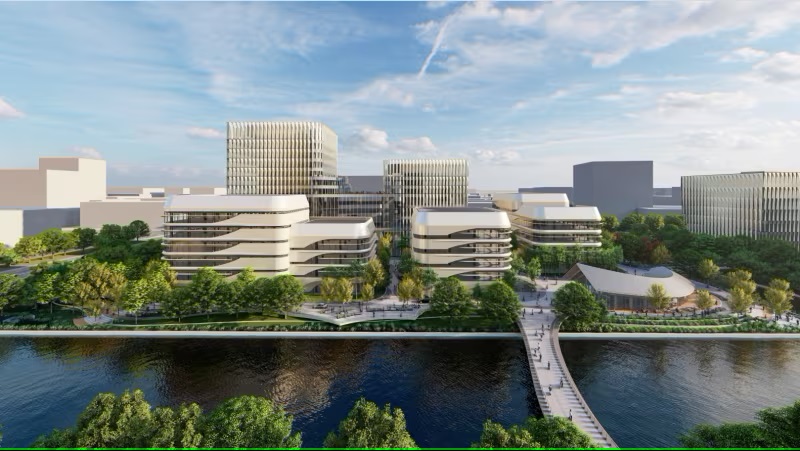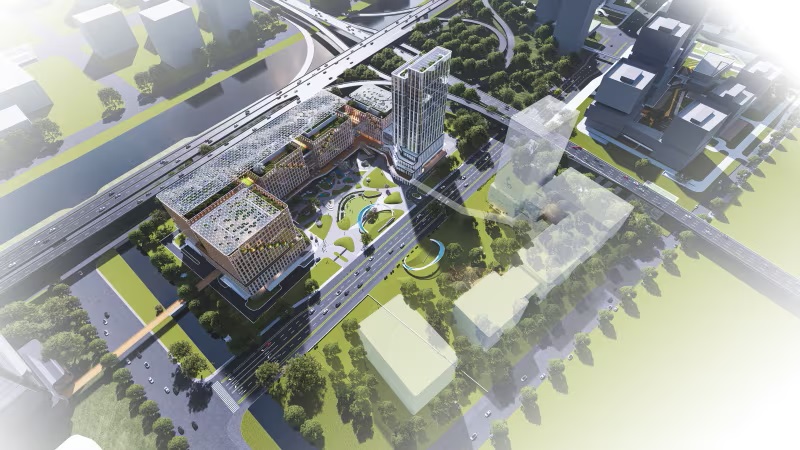‘Short-sighted and unwise’: SM Lee warns against writing off China, reaffirms Singapore’s continued confidence
China has shown that it can take a strategic perspective, riding through transient ups and downs, said the senior minister at an event in Suzhou to mark the 30th anniversary of the China-Singapore Suzhou Industrial Park (SIP).

Singapore Senior Minister Lee Hsien Loong delivers a keynote address at the China-Singapore Suzhou Industrial Park High-quality Development Forum on Nov 25, 2024. (Photo: Lee Gim Siong)

This audio is generated by an AI tool.
SUZHOU: Singapore remains confident in China’s future, Senior Minister Lee Hsien Loong said on Monday (Nov 25), cautioning it would be both "short-sighted" and "unwise” to dismiss the world's second-largest economy even as Beijing grapples with challenges at home and abroad.
To that end, Singapore believes a growing and prospering China can and should play a major constructive role internationally, remarked the veteran statesman, who is on a six-day official visit to the country.
“(China can contribute) to the prosperity and well-being of other countries, and a stable international order where all countries big and small co-exist peacefully together,” said Mr Lee, who was delivering the keynote address at a roundtable in Suzhou to mark the 30th anniversary of the China-Singapore Suzhou Industrial Park (SIP).
“We therefore wish China well in its efforts to transform its economy, integrate into the global economy, and enhance win-win relations with regional partners and other major powers.”
While in Suzhou, Mr Lee witnessed the signing of agreements about the SIP. They include the development of a 10-year blueprint to jointly chart the next leg of cooperation in the flagship bilateral venture and another on digital trade cooperation.
He also met with Chinese Vice Premier He Lifeng. They acknowledged the significant progress the SIP has made since its inception and reaffirmed their commitment to developing it into a world-class industrial zone focused on high-quality development.
“We should take the 30th anniversary of the development and construction of the park as a new starting point,” said Mr He. “Focus on the key links of the industrial chain and industry, further increase the efforts to attract investment, and innovate the way of attracting investment.”
Both leaders also participated in a tree-planting ceremony by Jinji Lake to mark the project’s 30th anniversary.
Mr Lee is in China till Friday. During his visit, he will call on and be hosted to dinner by President Xi Jinping in Beijing. Mr Lee will also meet overseas Singaporeans in Shanghai.
CHARTING THE PATH FORWARD
The blueprint to chart the direction of Suzhou Industrial Park for the next 10 years centres on the joint promotion of high-quality development.
“This cooperation initiative underscores Singapore’s and China’s continued commitment to strengthening the SIP’s role as a pathfinder for bilateral ties and advancing the SIP as a model for international cooperation,” Singapore’s Trade and Industry Ministry (MTI) said on Monday.
Both sides will:
- Support the SIP’s efforts in adopting more advanced standards, undertaking institutional reforms, experimenting with new policies, and creating a more conducive business environment
- Continue to support Singapore institutions and platforms in driving research and innovation in the SIP, and facilitating two-way internationalisation of enterprises from both sides
- Deepen cooperation in key sectors including the green economy, biomedical sciences, and the digital economy by working on landmark projects together
- Strengthen people-to-people exchanges between Singapore and China across government, business, academic and youth communities
- Continue to leverage relevant bilateral mechanisms to strengthen collaboration, pilot new initiatives and promote high-quality development of the SIP
A cutting-edge life sciences and biomedical innovation hub and a pilot zone aimed at cultivating leaders in digital transformation and sustainability are among the key projects mapped out to propel the next decade of development for SIP.
The former is Biosparc, a biosciences and medical technology hub that is a partnership between Singapore state investor Temasek and SIP.

Spanning at least 39 hectares with a total floor area of 92,000 sq m, the project aims to foster innovations in drug development, medical devices, life science tools, digital healthcare solutions, and AI-driven medical technologies, MTI said.
The park is currently under construction and is slated to open in 2026.
The China-Singapore Green Digital Hub (CSGDH) is the other earmarked project under the SIP development blueprint.
Designed as a research and development hub with integrated office spaces, it aims to serve as a model for future net-zero industrial districts in both Singapore and China. It will also function as a pilot zone for advanced decarbonisation solutions.
The hub is jointly developed by Sungent Holding Group - a Chinese state-owned enterprise in SIP - along with Singapore’s Keppel and Surbana Jurong Group. Covering 170,000 sq m, the CSGDH will be developed in four phases and is set to be completed in 2027.
To achieve its sustainability goals, the project will adopt a framework that covers the life cycle of an industrial district - that is, from upstream construction and design to downstream operations.

CONFRONTING A NEW REALITY
China is facing very different challenges after nearly 50 years of rapid progress following its reform and opening up journey, noted Mr Lee.
On the domestic front, the country is confronting a protracted property crisis, debt-ridden local governments, flagging consumption and a shrinking population. Beyond its borders, hot wars in Ukraine and Gaza pose geopolitical risks. There are also tensions with the United States, set to heat up under a Trump 2.0 presidency.
China’s growth will likely be slower just based on the domestic factors alone, said Mr Lee. He added that external pressures and uncertainties are compounding the matter, particularly by affecting cross-border trade and investments. As a result, China has been placing more emphasis on political, social and national security considerations.
“Economic development is still of high importance (to China), but is no longer the pre-eminent national priority. Policy trade-offs are unavoidable, and will imply less exuberant economic growth for China,” said Mr Lee.
However, the senior minister warned it would be both “short-sighted” and “unwise” to write China off.
“China’s development is an enterprise that will take 100 years. It has shown that it can take a strategic perspective to maintain consistent policies and direction over the long term, riding through transient ups and downs in its development journey,” Mr Lee pointed out.
The Chinese economy retains “considerable capacity” to grow, considering the untapped potential in its workforce and higher productivity from an increasingly urbanised population, he added.
Mr Lee also singled out China’s tech prowess as a key factor. He noted that Chinese companies have already established themselves as market leaders in industries such as electric vehicles, batteries, and solar panels.
“Increasingly, Chinese companies are competing as equals, rather than from a catch-up position. In fact, in some industries, Chinese companies have been so successful that it is causing concern to China’s trading partners,” added Mr Lee.
At the same time, Mr Lee highlighted the collective determination of the Chinese people as a pivotal element.
“We must never underestimate the Chinese people’s determination for their nation to succeed and stand tall in the world. This is a driving ambition. Its impact cannot be captured in economic statistics, but it will make all the difference.”

COMMITTED TO CONTINUED COOPERATION
Mr Lee reaffirmed Singapore’s commitment to deepening bilateral cooperation with China. He noted that cooperation in the SIP - the first government-to-government project between the two countries - will remain a key pillar in this regard.
Spanning 278 sq km, the park has evolved into a modern integrated township, home to 1.13 million residents and housing a China-Singapore cooperation area.
Singapore and China have developed a 10-year blueprint to chart the next leg of cooperation in the flagship bilateral venture, with plans to grow emerging sectors like green development, the digital economy, and biomedical sciences, Mr Lee highlighted.
Upcoming projects in this space will help the project stay relevant, and attract high-quality investments both from China and abroad, he noted.
One of China’s top industrial zones, SIP recorded a regional gross domestic product (GDP) of 368.6 billion yuan (US$51.4 billion) in 2023, a 5.9 per cent growth year-on-year. That figure was about 15 per cent of Suzhou city's GDP that year.

Mr Lee highlighted how the establishment of SIP 30 years ago was rooted in the shared political will of both governments, aiming for mutual benefit.
For China, SIP served as a platform to adapt Singapore’s expertise in economic development, investment promotion, and urban planning to its own national context. At the same time, the project allowed Singapore to gain deeper insights into China’s industries, market dynamics, and economy as Beijing integrated further into the global economy.
“(The SIP) showed how we had worked closely with China on a major project, and seen it through to fruition. This earned us international credibility. It also helped build up our reputation all over China too, opening many doors for us,” Mr Lee said.
While both countries shared common goals for the SIP, Mr Lee acknowledged that success did not come overnight. Instead, it took “unremitting effort” from thousands of leaders, officials, and businessmen on both sides, working closely to troubleshoot issues and progress the project.
SIP started with Singapore holding a majority 65 per cent stake and China holding the remainder. It suffered losses in the initial years amid stiff competition from a nearby rival business hub that was backed by the local government.
In December 1997, Singapore’s then-senior minister Lee Kuan Yew travelled to China. When in Suzhou, he openly criticised local officials over the matter. Later in Beijing, he received reassurances from then-Chinese president Jiang Zemin, who reaffirmed his country’s commitment to Suzhou Industrial Park.
This led to negotiations and an eventual change in ownership structure that took effect in 2001, reducing Singapore’s stake to 35 per cent while upping China’s to 65 per cent.

Both sides worked together in good faith and resolved differences through close consultations and mutual adjustments, Mr Lee noted.
“After the first few years, the Chinese side increasingly took the lead, eventually becoming the senior partner. They carried the project forward with energy and imagination, and built SIP up way beyond what we had dared to hope," said Mr Lee.
In the present, SIP’s continued development under the latest blueprint will demonstrate how China can deliver high standards of economic and urban management, and sustain a high-quality modern township over the long term, said the senior minister.
“It will also demonstrate China’s continuing openness to the world and its desire to welcome investors,” Mr Lee remarked.
“In an era of uncertainty and anxiety, it will be a beacon of cooperation and hope.”
















